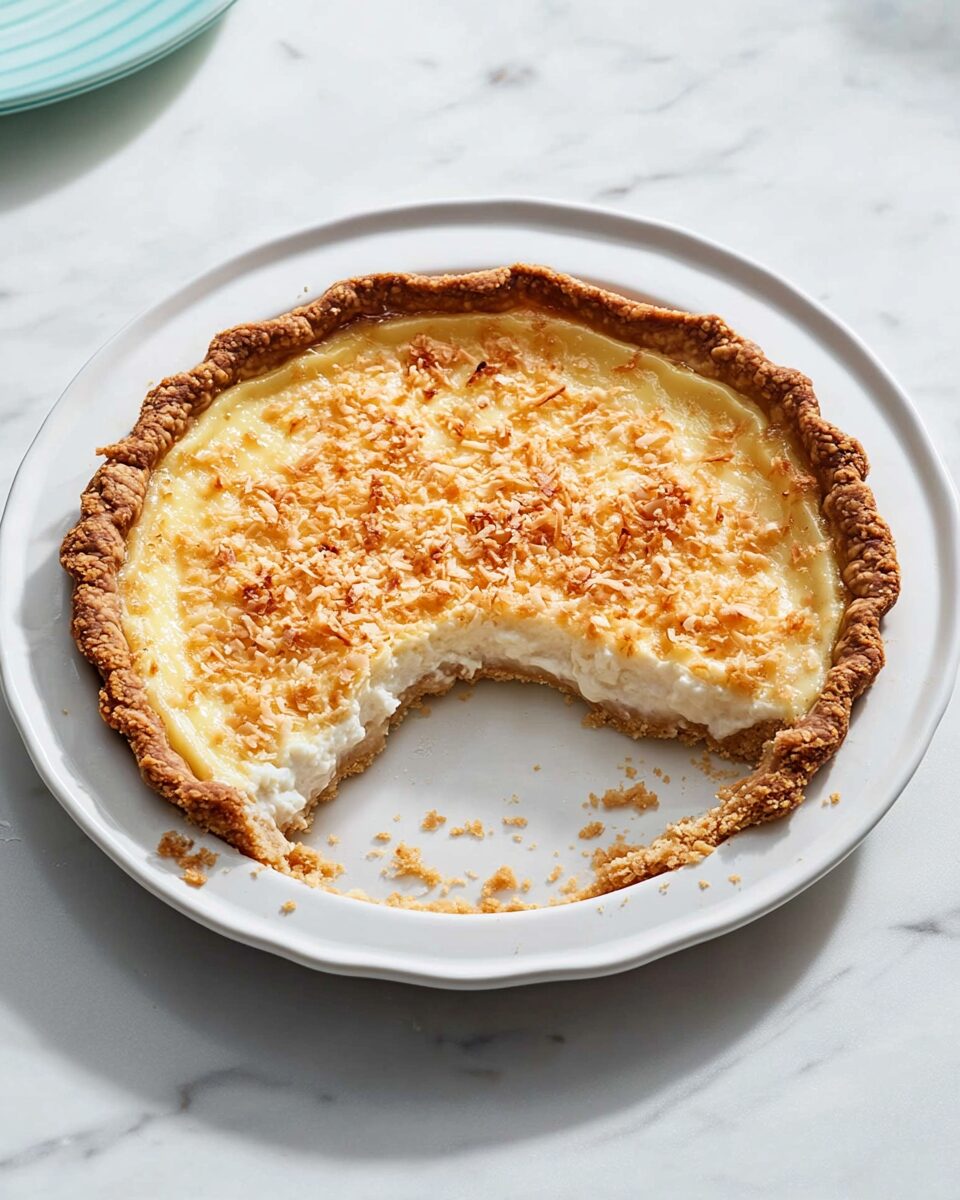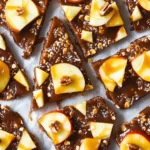This Coconut Pie is a simple yet delicious dessert with a rich, creamy custard filling and a perfectly toasted coconut topping. With minimal prep and a naturally crust-forming batter, it’s an ideal recipe for coconut lovers seeking a quick and satisfying treat.
FULL RECIPE
Ingredients
- 4 large eggs
- 1 ¾ cups granulated sugar
- ½ cup unsalted butter, melted
- ½ cup all-purpose flour
- 2 cups whole milk
- 1 teaspoon vanilla extract
- 1 cup sweetened shredded coconut
Directions
- Preheat oven to 350°F (175°C).
- In a large bowl, whisk together the eggs and sugar until smooth.
- Add the melted butter and mix well.
- Stir in the flour until fully incorporated.
- Pour in the milk and vanilla extract, stirring until the mixture is smooth.
- Fold in the shredded coconut.
- Pour the batter into a greased 9-inch pie plate.
- Bake for 45–50 minutes or until the top is golden and the center is set.
- Allow the pie to cool completely before serving.
- Serve chilled or at room temperature.
Nutritional Information
- Calories: 400
- Fat: 20g
- Saturated Fat: 13g
- Carbohydrates: 50g
- Sugar: 35g
- Protein: 6g
- Fiber: 1g
History of Coconut Pie
Coconut pie has long-standing roots in Southern American and tropical cuisines, where coconut is a staple ingredient. Originally popularized in areas where coconut was readily available, this dessert gradually made its way into mainstream American homes through handwritten family cookbooks and community potluck events. It became particularly popular in the mid-20th century, known for its ease of preparation and naturally sweet, nutty flavor.
Why Coconut Pie is So Loved
The popularity of coconut pie lies in its unique texture and flavor. Unlike other custard pies, the shredded coconut creates a slightly chewy consistency, offering a contrast to the soft, creamy filling. It appeals to those who appreciate traditional recipes with a homemade taste and comforting sweetness. Its crustless, self-forming nature also makes it less intimidating for beginner bakers.
Regional Variations
Depending on where you are in the world, coconut pie might be served in different ways. In the Southern U.S., it’s often sweet and rich, sometimes including buttermilk for a tangy twist. In Caribbean countries, it might be infused with rum or spices like nutmeg. Some regions also make use of coconut milk instead of dairy milk for a stronger coconut flavor and dairy-free option.
Texture and Consistency
This pie stands out because of its built-in texture contrast. The edges form a slight crust during baking, while the center remains creamy and custardy. The coconut shreds add a bite, making every forkful a multi-layered experience. It’s not overly firm like some pies, and not too soft like a pudding, striking the right balance.
Best Type of Coconut to Use
Sweetened shredded coconut is typically used in traditional recipes because it adds moisture and sweetness. However, unsweetened coconut can be substituted for those seeking a lower-sugar version. Toasting the coconut beforehand can intensify the nutty flavor and introduce a pleasant crisp texture to the top layer.
Dairy-Free and Vegan Alternatives
For those with dietary restrictions, coconut pie can be easily adapted. Using coconut milk or almond milk in place of dairy gives a similar creamy consistency. Egg substitutes such as flaxseed meal or commercial egg replacers work reasonably well, though the texture may vary slightly. Vegan butter or coconut oil can replace traditional butter for a plant-based version.
Serving Suggestions
Coconut pie is versatile when it comes to presentation. It can be served warm, room temperature, or chilled. Topping it with whipped cream, vanilla ice cream, or even fresh tropical fruits like pineapple can enhance the flavor profile and make it feel more indulgent. Some prefer a dusting of powdered sugar or cinnamon for added flair.
Perfect Occasions for Coconut Pie
This pie is a crowd-pleaser and fits a variety of occasions. It works well for holiday gatherings like Thanksgiving or Easter, summer picnics, birthday parties, and church suppers. Because it doesn’t require a crust, it’s easier to transport and slice, making it a great potluck option as well.
Storage and Shelf Life
Coconut pie should be stored in the refrigerator after it cools. It keeps well for up to 4 days in an airtight container. Freezing is also an option; simply wrap it tightly in plastic and foil before freezing for up to one month. When ready to serve, allow it to thaw in the fridge overnight.
Reheating Tips
To reheat coconut pie, warm individual slices in the microwave for 15 to 20 seconds or place the whole pie in a preheated 300°F oven for 10 to 15 minutes. Reheating restores some of the original creaminess and makes the coconut aroma more pronounced.
Coconut Pie vs Coconut Cream Pie
Many confuse coconut pie with coconut cream pie, but there are key differences. Coconut cream pie has a pre-baked crust, a cooked pudding filling, and is usually topped with whipped cream. In contrast, traditional coconut pie has a batter that bakes into a custard and often forms its own crust. Coconut pie is simpler and more rustic in presentation.
Health Considerations
While rich and sweet, coconut pie can be made slightly healthier with a few substitutions. Using low-fat milk, unsweetened coconut, and cutting back on sugar are effective ways to lighten it without sacrificing too much flavor. Keep in mind that coconut is high in saturated fat, so moderation is key.
Kid-Friendly Dessert
Coconut pie is often a hit with kids due to its creamy texture and sweet taste. Since it doesn’t contain nuts or chocolate, it’s a safe option for many school functions or child-friendly events. You can even make mini versions in muffin tins for individual servings.
Ingredient Customizations
You can easily tweak coconut pie to your taste. Adding citrus zest, a splash of almond extract, or a sprinkle of chocolate chips introduces new layers of flavor. You might also experiment with coconut cream or condensed milk for a richer version. These simple additions allow for creativity while keeping the essence of the pie intact.
Tips for Perfect Coconut Pie
To achieve the best results, ensure your ingredients are at room temperature before mixing. Do not overmix the batter to avoid creating air pockets. It’s also important to monitor baking time; overbaking can cause the pie to become rubbery, while underbaking may leave the center too soft.
Common Mistakes to Avoid
A common mistake is using too much coconut, which can make the pie overly chewy and dry. Skimping on eggs or milk may also affect the set of the custard. Always follow the recommended ratios and bake in a metal or glass pie dish for even heating.
Pairing Beverages with Coconut Pie
This pie pairs beautifully with beverages like coffee, black tea, or dessert wines. Tropical flavors such as pineapple juice or coconut-flavored drinks also complement the pie well. For a more refined pairing, consider a chilled Riesling or Moscato to balance the sweetness.
Using Leftovers Creatively
Leftover slices can be repurposed into other desserts. Crumble the pie and layer it with yogurt or whipped cream for a parfait. You can also reheat and serve it as a warm breakfast treat or crumble it over ice cream for added texture and flavor.
Making Coconut Pie in Advance
Coconut pie is ideal for making ahead of time. You can prepare and bake it a day in advance, then refrigerate until serving. This allows the flavors to meld and the pie to firm up, making slicing easier and the flavor deeper.
Conclusion
Coconut pie remains a cherished dessert for its simplicity, comfort, and versatility. Its humble ingredients create a satisfying balance of creamy, sweet, and chewy. Whether served at a festive gathering or enjoyed as a weekday indulgence, this pie offers a nostalgic yet timeless treat that’s hard to resist. Its adaptability for different diets and personal preferences ensures it continues to be a beloved recipe for generations to come.






